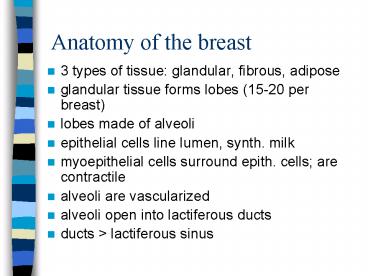Anatomy of the breast - PowerPoint PPT Presentation
1 / 7
Title:
Anatomy of the breast
Description:
1st week colostrum. yellowish, sticky secretion. small volume (40 mls / day) contains more protein, fat soluble vitamins, antibodies than milk produced later ... – PowerPoint PPT presentation
Number of Views:206
Avg rating:3.0/5.0
Title: Anatomy of the breast
1
Anatomy of the breast
- 3 types of tissue glandular, fibrous, adipose
- glandular tissue forms lobes (15-20 per breast)
- lobes made of alveoli
- epithelial cells line lumen, synth. milk
- myoepithelial cells surround epith. cells are
contractile - alveoli are vascularized
- alveoli open into lactiferous ducts
- ducts gt lactiferous sinus
2
Biochemistry of milk
- composition varies with time postpartum
- 1st week gt colostrum
- yellowish, sticky secretion
- small volume (40 mls / day)
- contains more protein, fat soluble vitamins,
antibodies than milk produced later - contains less fat and lactose
- subsequent milk production
- antibodies decreases
- protein content decreases
- fat content increases, as does lactose
- importance of lactose converted to galactose
essential for myelin formation in nervous tissue
3
Advantages of breast milk
- antibodies
- less sugar than infant formulas
- contains amino acids, fatty acids, cholesterol
not found in formulas - growth factors (epidermal growth factor)
- GnRH
- delta sleep inducing peptide
- less atherosclerosis, hypertension, allergies,
childhood diabetes, ear infections, SIDS, obesity
in breast fed babies - disadvantages of breast milk
- harmful substances ingested by mother can pass to
baby
4
Initiation of milk secretion
- breasts are adequately developed to begin milk
secretion during 4th month - doesnt begin until after parturition (even
though prolactin is high) - E and P inhibit prolactin action in mammary
tissue - prolactin will fall slowly after parturition if
suckling does not occur (over 3-4 weeks) - when suckling occurs, sensory nerves in nipple
convey info to spinal cord gt brainstem gt hypoth - results (data from rat studies)
- reduction in dopamine into portal vessels
- increased release of prolactin releasing factor
(vasoactive intestinal peptide, VIP) - increased VIP gene expression in PVN
5
Milk secretion, contd.
- amount of prolactin released depends on strength
and duration of suckling (twin studies) - prolactin release during one episode stimulates
milk production for next - prolactin is biggest determining factor re milk
secretion - secretion can be boosted by administering
thyrotropin releasing hormone (TRH or TRF)
6
Milk ejection reflex
- milk must be transported from lumen of alveolus
to nipple - transport induced by milk ejection reflex (MER)
- sensory information due to suckling travels via
spinal cord, brainstem to hypoth - activates oxytocin neurons in hypoth (both
synthesis and secretion) - oxytocin reaches alveoli gt activates receptors on
myoepithelial cells gt contraction - milk ejected thru nipple
- NOTE ejection is not due to sudden increase in
milk secretion into alveolus - MER can become a conditioned reflex in response
to other stimuli assoc with suckling (not true of
prolactin)
7
Milk ejection, contd.
- MER can be inhibited by physical, psychological
stress - mechanism unclear
- inhibition of oxytocin release?
- activ. of sympathetic nervous system gt
vasoconstriction gt limits access of oxytocin - suppression of lactation
- administration of sex steroids
- administration of bromocriptine (dopamine
receptor agonist)































